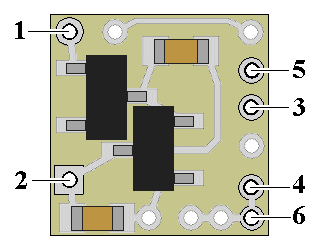Secure Site
Shop with
Confidence
Best viewed using:
Internet Explorer
or
Mozilla Firefox
NK8035 Pre-wired Lighthouse Beacon Kit
Product & installation overview:
The NK8035
is designed to generate slowly increasing & decreasing brightness for
two alternating LEDs connected to
the outputs
(solder points
3
thru
6) when power
is applied to the inputs (points
1 & 2). The lighting effect is timed to accurately
simulate the slowly rotating beacon in a
lighthouse having a white
(incandescent) beacon on the front and a green beacon on the back of the
rotating lenses.
Utilizing the industry’s smallest
microcontroller and associated voltage control circuitry, the total module
with LED
consumes less than
20 ma. This
makes the NK8035 well
suited for low power applications such as battery operation but can easily be
powered by any well-filtered and regulated DC power source with an output of
6-18VDC. The very small overall size of this module will allow it to be easily
placed in and around any structure, even in Z-scale.
Connecting the NK8035:
Installing
the NK8035 is very straightforward. Because the
module has circuitry on both sides, care must be taken to be sure that the
components or wire solder points will not make contact with any metal object which could cause a short
circuit.
This kit is
pre-wired with input power wires already connected. The red wire is for
connection to +DC and the black wire is for connection to –DC (ground). These
wires are pre-tinned for easy soldering
to your power source. Figure 1 below shows a close-up of the circuit and
wiring connections. Points 3 & 4 connect to the attached white LED, and points 5
& 6 connect to the green LED. Points 4 &6 are connected in common so there may
be a single wire used for common anode connections to both LEDs.
Important note:
A low-wattage
iron with a pointed tip should be used for connection of wires. Too much heat or
solder can easily damage the wires.

The white LED
is a Ngineering N1022C high intensity Incandescent LED. It is quite bright and
is constructed in a 2 X 3mm ceramic housing. The green LED is a Ngineering N1017
Micro Bright Signal green
LED. It is mounted just above the N1022C LED so both colors
appear to be from the same source point. The brightest light output will be seen
from the front of the LED surfaces, but these LEDs do also have relatively
bright “side-shine” allowing good viewing over a horizontal angle of up to 150
degrees. Plan the positioning of the LEDs in your model to “point” them toward
the middle of the viewing angle for best
effect.
We recommend
mounting the LEDs from the back by attaching adhesive to the wires near
the back of the LEDs so adhesive is not placed directly on the LED. It
is also recommended that whatever adhesive is used that it does not
contain high aggressive solvents that could attack the insulation on the
wires. Walthers Goo is an example of an “aggressive” solvent type
adhesive. Elmers white Glue, CA (superglue) and 2-part epoxies are very
safe for this type of mounting and will not damage wires or surfaces of
your model in most cases.
If the LEDs
are to be mounted slightly above a flat surface, we recommend cutting a
narrow slot from the edge of the surface to slide the wires into
position where the LED is to be located. Then gluing the wires in
position will be very easy and hold the LED in place while the adhesive
dries.
This
completes hookup of our NK8035 Lighthouse module. We hope the added
realism it provides enhances your enjoyment of the hobby.
© 2022 Ngineering

